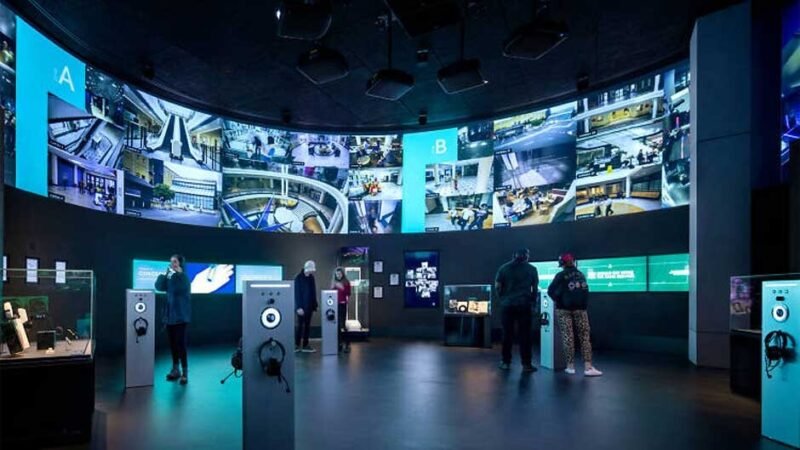Displays aren’t merely windows; they’re interactive experiences which capture viewers’ attention, transmit messages, and leave lasting imprints. All these captivating surroundings are backed up by trained specialists known as exhibition designers, whose meticulous planning and design of concepts, creation of layouts, and execution transform rooms into vibrant shows that showcase things, businesses, and ideas in a cut-through way.
Their expertise transforms bare space into living exhibits that speak about ideas, businesses, and products in an attention-grabbing way.
The Role of Exhibition Designers
The exhibition designer ensure that every space is equipped with an interesting story while remaining functional and interactive for visitors through the integration of functionality with design. They are responsible for designing spaces that communicate a specific theme or message and offer a seamless and pleasant experience for visitors. Work closely with clients, they interpret goals and turn them into interactive layouts.
To design aesthetically pleasing displays, these experts consider aspects such as lighting, materials, space planning, and branding. Their role is not only about looks; they also consider how to maximize space utilization and accessibility so that every exhibition is both interesting and memorable.
The Art of Designing Engaging Spaces
A good exhibit integrates creativity and functionality. Exhibition designers use various strategies—like interactive aspects, smart placement of displays, and visual storytelling—to involve visitors. Color schemes, texture, and multimedia integration are accountable for setting the mood in the space.
Through wise planning of these aspects, designers render the exhibit memorable and heighten audience interaction. Their ability to turn dull spaces into immersive spaces renders exhibits enjoyable and informative to audiences.
The Value of Technology in Exhibitions
Modern exhibits are more likely to adopt cutting-edge technology to enhance the visitor experience. Exhibit designers use digital display screens, augmented reality, and interactive installations to create dynamic presentations.
With touchscreens, virtual tours, or surround audio environments, these technological features enable visitors to engage with the information more directly. Through their implementation of new technology, designers enhance exhibits to be more engaging, accessible, and appealing to people from different backgrounds and learning styles.
Boosting Brand Visibility
Exhibitions are a force to be borne, and exhibition designers play the important role of making brands stand out. Carefully strategized, eye-catching booths designed by them cause visitors to drop by their stands and create the brand image.
Customized displays, lighting effects, and interactive product demonstrations assist businesses in achieving maximum exposure in trade shows and exhibitions. Good exhibition design enables brands to communicate their message loud and clear and to impress prospects to such an extent that they don’t forget the experience.
A fine exhibition is not so much about beauty—it interacts with visitors. Exhibition designers add interactive aspects such as touchscreens, demonstrations, and hands-on experiences to promote interaction. They also design pathways that prompt the visitors to walk around the area easily, thereby absorbing all the main points of interest.
By prioritizing visitor engagement, designers create experiences that are not just beautiful but informative and evocative too, establishing an individual connection to the subject and message of the exhibition.
Optimizing Use of Space
Space utilization is the basis of exhibition design. Exhibition designers carefully place displays to achieve maximum access and mobility, offering a comfortable way for visitors to walk through. They consider furniture placement, display height, and lighting to achieve maximum visibility and use. From small booths to big buildings, designers optimize every square inch. This careful planning enables exhibitors to communicate their material in a comprehensible and useful way.
Exhibition designers are tasked with making ordinary spaces vibrant, interactive exhibitions. With design, technical, and branding know-how, they design lasting experiences that interact with visitors and convey messages. From trade exhibitions, and museums, to corporate shows, a professional exhibition designer brings all the elements together to make a visually coherent and interactive exhibit. With innovative thinking and careful planning, they transform exhibitions into informative and memorable experiences.









Hi there! This article couldn’t be written much better! Going through
this article reminds me of my previous roommate! He continually
kept talking about this. I am going to forward this article to him.
Pretty sure he’ll have a very good read. Many thanks for sharing!
I every time spent my half an hour to read this webpage’s posts daily along with a cup
of coffee.
Thank you for your sharing. I am worried that I lack creative ideas. It is your article that makes me full of hope. Thank you. But, I have a question, can you help me?
Your point of view caught my eye and was very interesting. Thanks. I have a question for you.
Your point of view caught my eye and was very interesting. Thanks. I have a question for you.
Your point of view caught my eye and was very interesting. Thanks. I have a question for you.
I don’t think the title of your article matches the content lol. Just kidding, mainly because I had some doubts after reading the article.
Can you be more specific about the content of your article? After reading it, I still have some doubts. Hope you can help me.
Thank you for your sharing. I am worried that I lack creative ideas. It is your article that makes me full of hope. Thank you. But, I have a question, can you help me? https://www.binance.info/vi/register-person?ref=WTOZ531Y
Your article helped me a lot, is there any more related content? Thanks! https://www.gate.io/pt-br/signup?ref_type=103&ref=XwNAUwgM
Thanks for sharing. I read many of your blog posts, cool, your blog is very good.
Your point of view caught my eye and was very interesting. Thanks. I have a question for you.
Thank you for your sharing. I am worried that I lack creative ideas. It is your article that makes me full of hope. Thank you. But, I have a question, can you help me?
Thank you for your sharing. I am worried that I lack creative ideas. It is your article that makes me full of hope. Thank you. But, I have a question, can you help me?